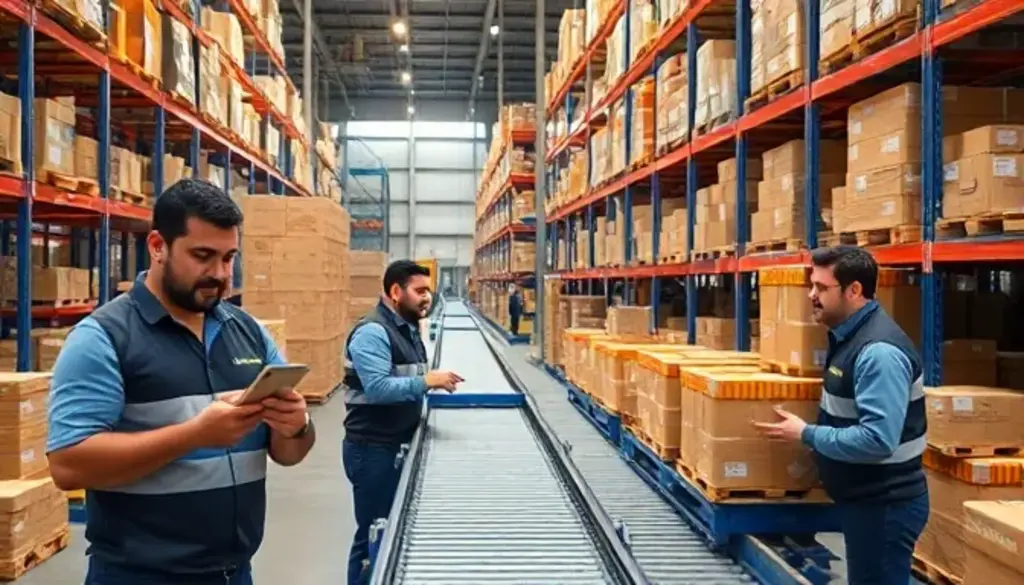Understanding Case Picking: Essential Benefits for Efficient Order Fulfillment
In the fast-paced world of logistics and supply chain management, efficiency and accuracy in order fulfillment are paramount. Case picking, a critical component of warehouse operations, serves as a linchpin in optimizing these processes. This blog post delves into the intricacies of case picking, exploring its definition, methodologies, and the substantial benefits it offers. By the end of this article, warehouse managers and logistics professionals will gain actionable insights to enhance their operations and improve customer satisfaction.
What is Case Picking? An Overview
Case picking is a warehouse operation process where entire cases or cartons of products are selected to fulfill orders. Unlike piece picking, which involves selecting individual items, case picking focuses on handling larger quantities, making it ideal for bulk orders. This method is particularly beneficial for businesses dealing with high-volume, low-variety products, where speed and efficiency are crucial.
In the broader context of warehouse operations, case picking fits into the picking process as a middle ground between piece picking and pallet picking. While piece picking is labor-intensive and time-consuming, pallet picking involves moving entire pallets, which may not always be practical for smaller orders. Case picking strikes a balance by allowing for efficient handling of medium-sized orders, thereby optimizing both labor and time resources.
Key Steps Involved in the Case Picking Process

The case picking process involves several key steps that ensure efficiency and accuracy. Initially, orders are received and processed through a warehouse management system (WMS), which organizes and prioritizes them based on urgency and availability. The next step involves selecting the appropriate cases from storage locations, often guided by technology such as barcode scanners or voice-picking systems.
Tools and technologies play a crucial role in streamlining the case picking process. Automated storage and retrieval systems (ASRS) and conveyor belts can significantly reduce manual labor, enhancing speed and accuracy. Additionally, warehouse workers require specific training to operate these technologies effectively, ensuring they can handle equipment safely and efficiently.
The skills required for effective case picking extend beyond technical know-how. Workers must possess a keen eye for detail, physical stamina, and the ability to work quickly under pressure. Continuous training and development programs are essential to maintain high standards of performance and safety in warehouse operations.
Major Benefits of Case Picking for Order Fulfillment
Case picking offers several advantages that can transform order fulfillment processes. One of the primary benefits is enhanced efficiency and accuracy. By handling entire cases, warehouses can reduce the time spent on picking individual items, thereby speeding up the order fulfillment process. This efficiency translates into faster delivery times, which is a critical factor in customer satisfaction.
Cost implications and potential savings are also significant. Although the initial investment in technology and training may be substantial, the long-term savings in labor costs and increased throughput can offset these expenses. By optimizing the picking process, warehouses can reduce errors and minimize the need for costly returns or re-shipments.
Moreover, case picking positively impacts delivery times and customer satisfaction. Faster order processing and reduced errors lead to timely deliveries, enhancing the overall customer experience. In a competitive market, this can be a decisive factor in retaining customers and building brand loyalty.
Integrating Case Picking into Your Warehouse Operations

Implementing case picking in a warehouse requires careful planning and execution. The initial steps involve evaluating current operations to identify areas for improvement and potential integration points. This evaluation should consider factors such as order volume, product types, and existing infrastructure.
Once the evaluation is complete, the next step is to integrate new processes and technologies. This may involve upgrading existing systems or investing in new equipment, such as automated picking systems or advanced WMS. Training staff to adapt to these changes is crucial to ensure a smooth transition and maintain productivity.
Overcoming common challenges during integration is essential for success. Resistance to change, technical issues, and initial disruptions in workflow are common obstacles. To address these, clear communication, ongoing support, and continuous monitoring of performance metrics are vital. By proactively managing these challenges, warehouses can achieve a seamless integration of case picking into their operations.
Case Studies: Successful Case Picking Implementations
Real-world examples of successful case picking implementations provide valuable insights into the potential benefits and strategies involved. For instance, a leading retail chain implemented an automated case picking system, resulting in a 30% increase in order processing speed and a 20% reduction in labor costs. The company achieved these results by investing in advanced robotics and optimizing their warehouse layout to facilitate efficient picking routes.
Another example is a food distribution company that adopted voice-picking technology to enhance accuracy and speed. By training their staff to use this technology, the company reduced picking errors by 50% and improved overall customer satisfaction. These case studies highlight the importance of leveraging technology and training to achieve significant improvements in warehouse operations.
Lessons from these implementations can be applied in various warehouse settings. Key takeaways include the importance of investing in the right technology, providing comprehensive training, and continuously monitoring performance to identify areas for further improvement.
Future Trends in Case Picking and Warehouse Management

The future of case picking and warehouse management is poised for exciting developments. Emerging technologies such as artificial intelligence (AI), machine learning, and the Internet of Things (IoT) are set to revolutionize the industry. These innovations promise to enhance automation, improve accuracy, and provide real-time data insights for better decision-making.
As these technologies evolve, their impact on warehouse operations and order fulfillment will be profound. AI-powered systems can optimize picking routes, predict demand patterns, and automate routine tasks, freeing up human resources for more strategic roles. IoT devices can provide real-time tracking and monitoring, ensuring transparency and efficiency throughout the supply chain.
Staying updated with industry trends is crucial for continuous improvement. Warehouse managers must remain informed about technological advancements and be prepared to adapt their operations accordingly. By embracing innovation and fostering a culture of continuous learning, businesses can maintain a competitive edge in the ever-evolving logistics landscape.
ASC Software: Optimizing Case Picking for Maximum Efficiency
ASC Software provides cutting-edge warehouse management solutions that streamline case picking processes, ensuring higher accuracy and efficiency. With our powerful ASCTrac® WMS, businesses can optimize case picking operations through intelligent automation, real-time inventory tracking, and seamless system integrations.
How ASC Software Enhances Case Picking:
- Advanced Order Processing: ASCTrac® WMS intelligently prioritizes case picking tasks based on real-time inventory levels and demand forecasts.
- Automated Picking Solutions: ASC Software integrates with robotics, conveyor systems, and pick-to-light technology to minimize manual labor and increase efficiency.
- Error Reduction & Accuracy: By utilizing barcode scanning and verification tools, ASC Software helps warehouses significantly reduce picking errors.
- Seamless ERP Integration: ASCTrac® WMS connects effortlessly with existing ERP systems, ensuring smooth data flow and optimized warehouse operations.
For businesses looking to enhance order fulfillment and reduce operational costs, ASC Software offers a scalable and adaptable solution tailored to meet warehouse-specific needs.
Conclusion
In conclusion, case picking is a vital component of efficient order fulfillment, offering numerous benefits in terms of speed, accuracy, and cost savings. By understanding and implementing effective case picking strategies, warehouse managers can significantly enhance their operational workflows and improve customer satisfaction. As the industry continues to evolve, staying informed about emerging trends and technologies will be key to maintaining a competitive advantage.
Ready to Optimize Your Case Picking Process?
Efficient case picking is crucial for warehouse productivity and customer satisfaction. With the right technology and strategy, you can significantly improve speed, accuracy, and cost savings. ASC Software provides the tools and expertise to help you implement a seamless case picking system.
Explore ASCTrac® WMS today and take your warehouse operations to the next level. Contact us to learn more.
Frequently Asked Questions (FAQ)
How does case picking differ from piece picking?
Case picking involves selecting entire cases of products, whereas piece picking refers to selecting individual items. This distinction affects the speed and logistics of the picking process, with case picking generally being faster and more efficient for bulk orders.
What are the initial costs involved in shifting to case picking?
Initial costs can include investments in specialized equipment, such as automated picking systems, and training for staff to operate these technologies. Additionally, system upgrades to integrate new processes may be necessary. However, these costs are often offset by long-term efficiency gains and reduced labor expenses.
Can small to medium enterprises benefit from case picking?
Yes, small to medium enterprises (SMEs) can benefit significantly from case picking, especially if they deal with bulk orders or products that are typically sold in cases. By optimizing their picking processes, SMEs can improve efficiency, reduce errors, and enhance customer satisfaction, leading to potential growth and increased competitiveness.
What technologies are commonly used in case picking?
Technologies such as warehouse management systems (WMS), automated storage and retrieval systems (ASRS), and robotics are commonly integrated into case picking operations. These technologies enhance efficiency by automating routine tasks, improving accuracy, and providing real-time data insights for better decision-making.
How can I measure the success of case picking in my warehouse?
Success can be measured by improvements in order fulfillment speed, accuracy, reduced labor costs, and enhanced customer satisfaction. Regular performance reviews and metrics analysis, such as tracking error rates, order processing times, and customer feedback, are essential to assess the effectiveness of case picking operations.




